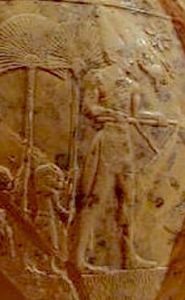There may have been two rulers in the predynastic period with the name Scorpion. The later of the two rulers was thought to have ruled Upper Egypt at the end of Dynasty 0 (at the beginning of the Early Dynastic Period).
The name Scorpion was found written inside a serekh on a wine jar from Minshat Abu Omar (Van den Brink). However, Wildung has argued that this should be read as Aha. Petrie found the name Scorpion written in ink inside a serekh on two pottery vessels found in Tarkhan. However, following their examination by infra-red photography, Dreyer has argued that these serekhs actually relate to an earlier ruler named Crocodile. Van den Brink has supported this proposition and translated the text as “Horus (Crocodile) the subduer”.
An incomplete macehead was recovered from the “main deposit” of the temple of Nekhen (Hierakonpolis) by J.E. Quibell in 1897. The macehead depicts a ruler wearing the white crown of Upper Egypt engaged in a ritual. Above the ruler there are a series of standards from which hang noosed lapwings, representing the common people who have been “overcome” by Scorpion.


In 1995 the “Scorpion Tableau” was discovered by J.C Darnell and D Darnell at Gebel Tjauti (south east of Abydos). They have suggested that the tableau depicts a victory procession led by King Scorpion (whose name is written as a hawk above a scorpion) and proposed that Scorpion defeated the ruler of Naqada and unified Upper Egypt as a prelude to the unification of Upper and Lower Egypt by Narmer. It is also contended that this Scorpion was one and the same as the “earlier” ruler named Scorpion (who was buried in tomb U-J at Abydos).
Assuming that Scorpion did in fact exist, it is suggested that rather than hailing from This (Abydos), like his contemporary rulers, he was from the ancient town of Nekhen (Trigger et al 1983). This is largely due to the fact that his macehead was discovered in the cache at Nekhen and so is hardly conclusive. The Narmer Macehead and Palette were also found in the main deposit of the temple of Nekhen and there is no other evidence to support the conclusion that Scorpion was based there rather than in This (Abydos).
The similarity in the style of the Scorpion Macehead and the Narmer Macehead has led experts to suggest that they were contemporaries (and possibly opponents), but it is also proposed by some that Scorpion was actually Narmer (Vikentiev, Baumgartel).
No burial site has been conclusively linked to Scorpion but it is possible that an uninscribed four chambered tomb (B50) in Abydos was his resting place (Dreyer 1990). Alternatively, Darnell may be right to ascribe tomb U-J (Abydos) to him. However, it is notable that no artefacts attributed to or referring to Scorpion have been found at Abydos and Bard (2008) suggests that tomb U-J is at least one hundred years older than the tombs of dynasty 0 at Abydos.
Bibliography
- Adams, Barbara and Cialowicz, Krzysztof (1998) Protodynastic Egypt
- Bard, Kathryn (2008) An introduction to the Archaeology of Ancient Egypt
- Clayton, Peter A (1994) Chronicle of the Pharaohs
- J.C. Darnell, et al (2002) Theban Desert Road Survey in the Egyptian Western Desert 1
- Kemp, Barry J (1991) Ancient Egypt: Anatomy of a Civilisation
- Wilkinson,Toby A H (1999) Early Dynastic Egypt
- Wilkinson, Toby A H(2000) What a King Is This: Narmer and the Concept of the Ruler from The Journal of Egyptian Archaeology
Copyright J Hill 2016